Description
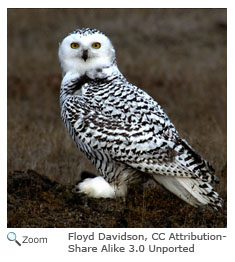 With its dense white plumage, the Snowy Owl is easily recognizable. Fit to survive in the Arctic, its thick feathers make it the heaviest owl in North America. Females are white with dark markings, while males are usually completely white. Both males and females have yellow eyes and neither have ear tufts. With its dense white plumage, the Snowy Owl is easily recognizable. Fit to survive in the Arctic, its thick feathers make it the heaviest owl in North America. Females are white with dark markings, while males are usually completely white. Both males and females have yellow eyes and neither have ear tufts.
Range
The Snowy Owl is migratory. In the summer, it lives in the Arctic Circle from northern Alaska to Northeastern Canada. In the winter, the Snowy Owl is in search of food. Its winter range extends from central Canada throughout the central United States. It can be found as far south as Oklahoma.
Habitat
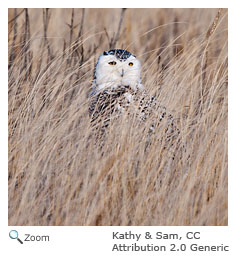 The Snowy Owl prefers open land at low elevations. It can be found in open tundra and fields. The Snowy Owl also frequents wet meadows when hunting. The Snowy Owl prefers open land at low elevations. It can be found in open tundra and fields. The Snowy Owl also frequents wet meadows when hunting.
|
|
Diet
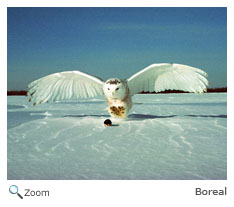 The Snowy Owl has a varied diet. It prefers small mammals such as lemmings and mice, but also preys on rabbits, seabirds and fish. It can consume up to 1,600 lemmings a year. It hunts from an elevated point and wait for their food to come into view. To scan the fields for food, the Snowy Owl can swivel its head 270 degrees! The Snowy Owl has a varied diet. It prefers small mammals such as lemmings and mice, but also preys on rabbits, seabirds and fish. It can consume up to 1,600 lemmings a year. It hunts from an elevated point and wait for their food to come into view. To scan the fields for food, the Snowy Owl can swivel its head 270 degrees!
Life Cycle
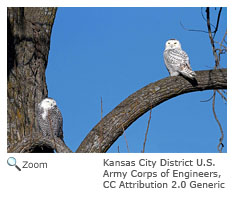 Breeding occurs between May and September. The female find a nesting spot on the bare ground and scrape out a shallow bowl in the ground to create a nest. Breeding occurs between May and September. The female find a nesting spot on the bare ground and scrape out a shallow bowl in the ground to create a nest.
She lays between 3 and 11 white eggs, but can lay up to 16 eggs if food is abundant. Eggs are incubated for about one month and then hatch. Both parents feed and protect the chicks; the male brings food to the nest. After 5 to 7 weeks, the chicks can hunt for themselves and leave the nest.
Behavior
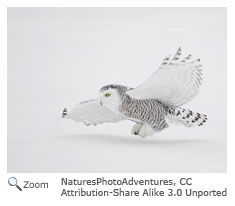 Humans are probably the most threatening predator, using the Snowy Owl for food, trophies, and to protect game animals. To defend their nest or attack, the Snowy Owl will dive-bomb its predators. Humans are probably the most threatening predator, using the Snowy Owl for food, trophies, and to protect game animals. To defend their nest or attack, the Snowy Owl will dive-bomb its predators. |





